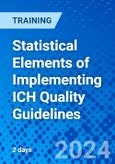Most organizations have programs and procedures but they contain holes or fall short in the implementation of the tools and techniques used to apply proper statistical reasoning and analysis to ICH guidelines. Statistics can help you to better understand, implement, and track processes covered by the ICH guidelines?
This 2-day seminar explores the unique challenges facing quality functions of pharmaceutical and biotechnology companies. Attendees will learn practical implementation solutions as well as best practice descriptions that will allow management to effectively assess, manage and mitigate risk of poorly designed studies. Participants will learn statistical methods related to ICH guidelines and will discover how regulatory agencies, such as the FDA expect organizations to meet these guidelines.
This seminar will provide attendees with an understanding of the fourteen ICH Quality guidelines as relates to statistical guidance and analysis. The course will provide tools, techniques and insight that will allow participants to immediately begin implementation of the information learned within their organization/firm.
LEARNING OBJECTIVES:
Upon completion of the course, you will be able to:
- Compare FDA requirements to ICH guidelines.
- Perform comparative analyses and regression analysis.
- Know the difference between confidence and tolerance intervals.
- Calculate the appropriate sample size.
- Calculate the probability of risk.
- Design and perform statistical tests for comparisons, stability, validation, impurities
SEMINAR OBJECTIVES
Day 1: ICH review and Statistics Fundamentals
Review ICH Quality Guidelines (Q Series)
- Q1 Stability Testing
- Q2 Analytical Validation
- Q3A-3E Impurities
- Q4 Pharmacopoeias
- Q5A-5E Quality of Biotechnological Products
- Q6A-6B Specifications
- Q7 Good Manufacturing Practice
- Q8 Pharmaceutical Development
- Q9 Quality Risk Management
- Q10 Pharmaceutical Quality System
- Q11 Development and Manufacture of Drug Substances
- Q12 Lifecycle Management
- Q13 Continuous Manufacturing of Drug Substances and Drub Products
- Q14 Analytical Procedure Development
- Developing a Quality Risk Management Plan
2. Fundamentals of Statistics
- Normal Distribution
- Descriptive and Summary Statistics
- Graphical Techniques
- Null Hypothesis Statistical Testing
- Confidence and Tolerance Intervals
- Statistical vs. Meaningful Significance
Day 2: Statistical Tests and Applications to Industry
1. Statistical Analyses
- Comparative Statistics
- Regression Analysis
- Sample Size (Power Analysis)
- Discussion/Questions
2. Application to Industry
-
- Design of Experiments (DOE)
- Setting Specifications/Thresholds/Acceptance Criteria
- Stability/Shelf-Life Testing
- Assay Validation
- Impurities
- Discussion/Questions
Course Content
DAY 1 (10:00 AM TO 4:00 PM EDT)
- Introduction to Clinical Project Management: Overview of project management; roles and responsibilities of the clinical project manager; establishment of project teams.
- Strategic Project Planning: Review of the project charter; risk identification to clinical research projects; development of a project plan; creation of the work breakdown structure in a project.
- Process Mapping as a Planning and Management Tool.
- Effective Schedule Management: Defining project scope; creation of realistic schedules; identification of critical path to a project; effectively managing change orders and out of scope to your project.
DAY 2 (10:00 AM TO 4:00 PM EDT)
- Costs Estimation, Creation and Management of Budgets: Effective project budget planning and tracking.
- Outsourcing Strategies. Vendor Management and Oversight: Qualification, selection, and oversight of vendors in clinical research projects.
- Tracking Projects: Risk, Cost and Change Management. Development and Implementation of Quality Control and Risk Management Systems and Key Performance Indicators.
- Project Closure: Effectively closing a project and lessons learned.
- Group work on the Case study
- Case Study: Quality by Design (QbD) and Risk-Based Quality Management (RBQM) Techniques Applied to the Planning and Execution of a Clinical Trial.
- Discussion of the Case study and Closing remarks
Speakers
ELAINE EISENBEISZ
Elaine Eisenbeisz is a private practice statistician and owner of Omega Statistics, a statistical consulting firm based in Southern California. Elaine has over 30 years of experience in creating data and information solutions for industries ranging from governmental agencies and corporations, to start-up companies and individual researchers. In addition to her technical expertise, Elaine possesses a talent for conveying statistical concepts and results in a way that people can intuitively understand.
Elaine’s love of numbers began in elementary school where she placed in regional and statewide mathematics competitions. She attended University of California, Riverside, as a National Science Foundation scholar, where she earned a B.S. in Statistics. Elaine received her Master’s Certification in Applied Statistics from Texas A&M and continues to learn from her practice. Elaine is a member in good standing with the American Statistical Association as well as many other professional organizations. She is also a member of the Mensa High IQ Society. Omega Statistics holds an A+ rating with the Better Business Bureau.
Elaine has designed the methodology for numerous studies in the clinical, biotech, and health care fields. She designs and analyzes studies as a contract statistician for pharmaceutical and proton therapy research. She also works on nutriceutical and fitness studies. Elaine works as a contract statistician with numerous private researchers, CRO’s and biotech start-ups as well as with larger companies such as Allergan, Intuitive Surgical, Guardant Health, Nutri-System, Amazon, and Rio Tinto Minerals.
Not only is Elaine well versed in statistical methodology and analysis, she works well with project teams. Throughout her tenure as a private practice statistician, she has published work with researchers and colleagues in peer-reviewed journals.
Who Should Attend
- Quality Assurance Departments
- Quality Control Departments
- Analytical Validation scientists and personnel
- Assay Development Scientists
- Quality Analysts
- Research Scientists
- Risk Managers








